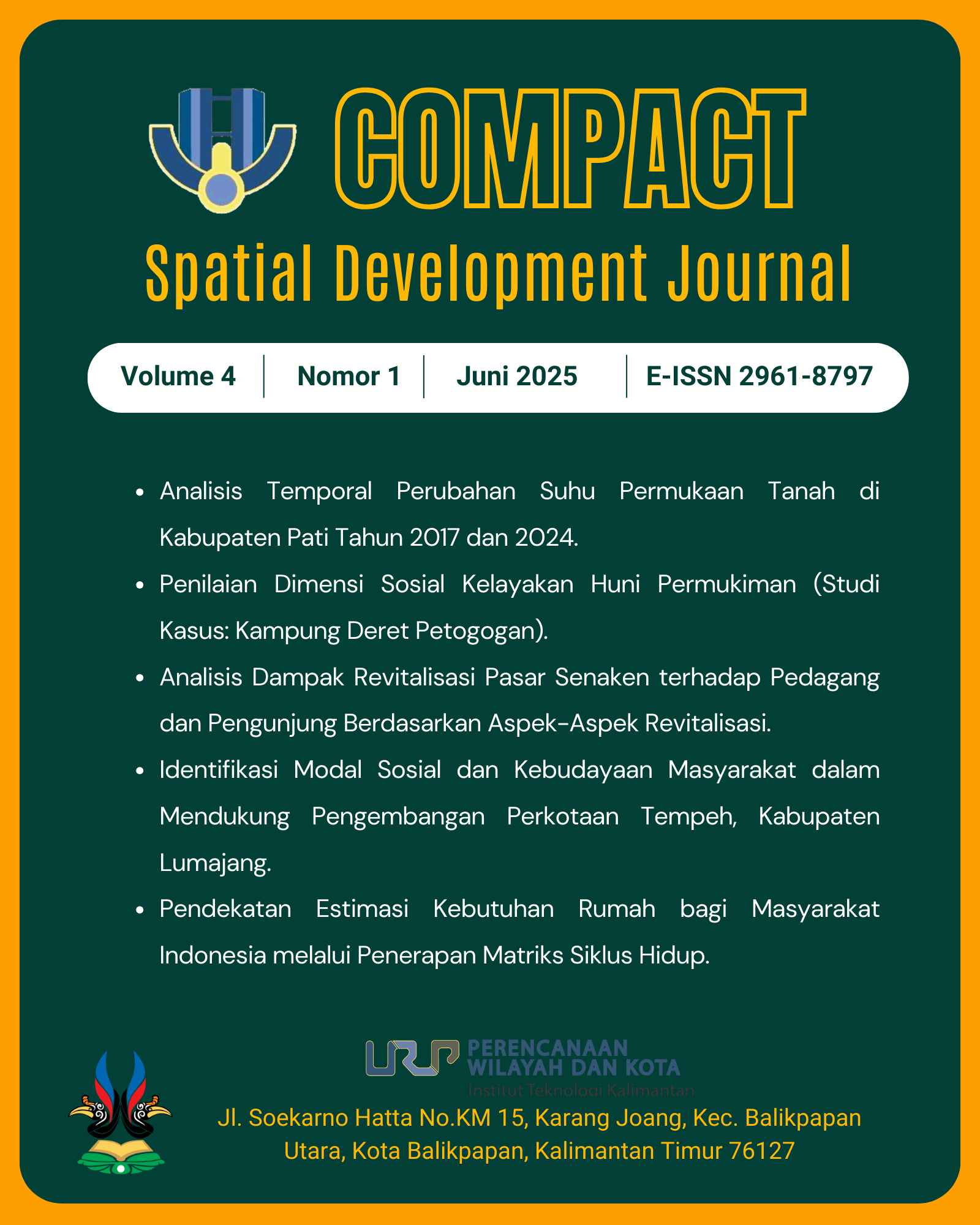Pendekatan Estimasi Kebutuhan Rumah bagi Masyarakat Indonesia melalui Penerapan Matriks Siklus Hidup
DOI:
https://doi.org/10.35718/compact.v4i1.1311Kata Kunci:
Backlog Perumahan, Matriks Siklus Hidup (Life Cycle Matrix - LCM), Kebutuhan Perumahan, Perencanaan PerumahanAbstrak
Penelitian ini bertujuan untuk memperkirakan kesenjangan antara jumlah rumah yang tersedia dan yang dibutuhkan oleh masyarakat (Ananta, 2020), yang sering kali diukur melalui backlog perumahan. Backlog dalam perumahan mencakup backlog kepemilikan, yaitu persentase rumah tangga yang memiliki rumah sendiri; dan backlog kepenghunian, yaitu kondisi ideal di mana satu rumah dihuni oleh satu keluarga. Dengan pertumbuhan populasi dan urbanisasi yang pesat di Indonesia, estimasi kebutuhan rumah menjadi sangat penting untuk memastikan ketersediaan perumahan yang memadai dan layak bagi seluruh lapisan masyarakat. Penelitian ini mengkaji pendekatan yang dapat digunakan untuk menerapkan Matriks Siklus Hidup (Life Cycle Matrix - LCM), yang pertama kali diperkenalkan di Jepang pada tahun 1980-an, untuk memperkirakan kebutuhan rumah berdasarkan perubahan siklus hidup rumah tangga, seperti perubahan ukuran rumah tangga dan umur kepala rumah tangga.
Metode penelitian yang digunakan adalah pendekatan kuantitatif dengan metode deskriptif dan analitis. Data yang digunakan merupakan data sekunder, yaitu Hasil Sensus Penduduk dari Badan Pusat Statistik (BPS, sebelumnya dikenal dengan Biro Pusat Statistik). Tahap analisis meliputi verifikasi ketersediaan data dan pembersihan data. Kemudian dilakukan perhitungan backlog perumahan, serta pengembangan pendekatan yang dapat dikembangkan untuk Estimasi Kebutuhan Rumah bagi Masyarakat Indonesia melalui penerapan Matriks Siklus Hidup. Penelitian ini diharapkan dapat memberikan kontribusi signifikan dalam membangun pemahaman sebagai pendekatan untuk menerapkan data Hasil Sensus Penduduk menjadi Matriks Siklus Hidup.
Referensi
Badan Pusat Statistik. (2000). Sensus Penduduk 2000: Data lengkap. Jakarta: BPS. Diakses dari https://www.bps.go.id/ pada Desember 2024.
Badan Pusat Statistik. (2001). Statistik Indonesia 2000. Jakarta, Indonesia: Badan Pusat Statistik. Diakses dari https://www.bps.go.id/ pada Desember 2024.
Badan Pusat Statistik. (2001). Statistik Perumahan dan Permukiman 2000. Diakses dari https://www.bps.go.id/ pada Desember 2024.
Badan Pusat Statistik. (2010). Sensus Penduduk 2010: Data lengkap. Jakarta: BPS. Diakses dari https://www.bps.go.id/ pada Desember 2024.
Badan Pusat Statistik. (2011). Statistik Perumahan dan Permukiman 2010. Diakses dari https://www.bps.go.id/ pada Desember 2024.
Badan Pusat Statistik. (2020). Sensus Penduduk 2020: Data lengkap. Jakarta: BPS. Diakses dari https://www.bps.go.id/ pada Desember 2024.
Badan Pusat Statistik. (2023). Indikator Perumahan 1993-2022. Diakses dari https://www.bps.go.id/statictable/2009/03/12/1537/indikator-perumahan-1993-2022.html
Badan Pusat Statistik. (2023). Statistik Perumahan dan Permukiman 2022. Diakses dari https://www.bps.go.id/ pada Desember 2024.
Behr, D. M., Chen, L., Goel, A., Haider, K. T., Singh, S., & Zaman, A. (2021). Introducing the Adequate Housing Index: A New Approach to Estimate the Adequate Housing Deficit within and across Emerging Economies. Policy Research Working Paper; No. 9830. © World Bank, Washington, DC. http://hdl.handle.net/10986/36481 License: CC BY 3.0 IGO.
Biro Pusat Statistik. (1962). Sensus Penduduk 1961: Republik Indonesia. Jakarta, Indonesia: Biro Pusat Statistik. Diakses dari https://www.bps.go.id/ pada Desember 2024.
Biro Pusat Statistik. (1972). Sensus Penduduk 1971: Tabel-Tabel Pendahuluan, Serie C. Jakarta: Biro Pusat Statistik. Diakses dari https://www.bps.go.id/ pada Desember 2024.
Biro Pusat Statistik. (1982). Sensus Penduduk 1981: Data lengkap. Jakarta, Indonesia: Biro Pusat Statistik. Diakses dari https://www.bps.go.id/ pada Desember 2024.
Biro Pusat Statistik. (1983). Proyeksi Penduduk Indonesia 1980-2000. Jakarta, Indonesia: Biro Pusat Statistik. Diakses dari https://www.bps.go.id/ pada Desember 2024.
Biro Pusat Statistik. (1991). Sensus Penduduk 1990: Data lengkap. Jakarta, Indonesia: Biro Pusat Statistik. Diakses dari https://www.bps.go.id/ pada Desember 2024.
Biro Pusat Statistik. (1991). Statistik Indonesia 1990. Jakarta, Indonesia: Biro Pusat Statistik. Diakses dari https://www.bps.go.id/ pada Desember 2024.
DTZ Pieda Consulting. (2005). Housing Need Backlog: Overview, South Hampshire Housing Market Assessment. Retrieved from https://www.push.gov.uk/wp-content/uploads/2018/06/SHMA-2014-1.pdf diunduh tanggal 01 Desember 2024.
Ho, C. S., & Lim, S. B. (2008). Evaluation On The Application Of Life Cycle Matrix (LCM) In Forecasting Housing Needs And Housing Demand In Develop And Developing Countries.
Ramadhanti, T., Suhab, S., & Fitrianti, R. (2023). Analisis determinan permintaan dan penawaran perumahan di Kabupaten Kolaka. Jurnal Ekonomika dan Dinamika Sosial, 2(1), 17–40.
Satoto, E. B. (2023). Boosting Homeownership Affordability for Low-Income Communities in Indonesia. International Journal of Sustainable Development & Planning, 18(5).
United Nations (1956). Manual III: Methods for Population Projections by Sex and Age. Edited by Population Division Department of Economic and Social Affairs. Vol. 25, Population Studies. New York: United Nations.
Wu, Y. T., Niubo, A. S., Daskalopoulou, C., Moreno-Agostino, D., Stefler, D., Bobak, M., Oram, S., Prince, M., & Prina, M. (2021). Sex differences in mortality: Results from a population-based study of 12 longitudinal cohorts. Cmaj, 193(11), E361– E370. https://doi.org/10.1503/cmaj.200484
Unduhan
Diterbitkan
Versi
- 2025-10-09 (2)
- 2025-09-28 (1)
Cara Mengutip
Terbitan
Bagian
Lisensi
Hak Cipta (c) 2025 COMPACT: Spatial Development Journal

Artikel ini berlisensi Creative Commons Attribution-NonCommercial 4.0 International License.









